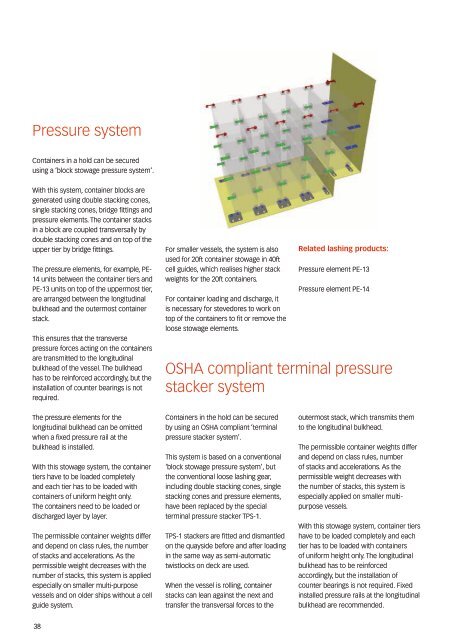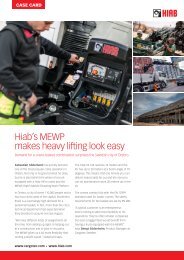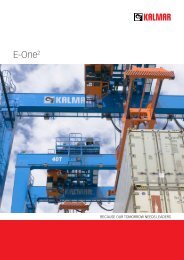Container securing systems Product catalogue - Cargotec, Inc.
Container securing systems Product catalogue - Cargotec, Inc.
Container securing systems Product catalogue - Cargotec, Inc.
Create successful ePaper yourself
Turn your PDF publications into a flip-book with our unique Google optimized e-Paper software.
Pressure system<br />
<strong>Container</strong>s in a hold can be secured<br />
using a ‘block stowage pressure system’.<br />
With this system, container blocks are<br />
generated using double stacking cones,<br />
single stacking cones, bridge fittings and<br />
pressure elements. The container stacks<br />
in a block are coupled transversally by<br />
double stacking cones and on top of the<br />
upper tier by bridge fittings.<br />
The pressure elements, for example, PE-<br />
14 units between the container tiers and<br />
PE-13 units on top of the uppermost tier,<br />
are arranged between the longitudinal<br />
bulkhead and the outermost container<br />
stack.<br />
This ensures that the transverse<br />
pressure forces acting on the containers<br />
are transmitted to the longitudinal<br />
bulkhead of the vessel. The bulkhead<br />
has to be reinforced accordingly, but the<br />
installation of counter bearings is not<br />
required.<br />
The pressure elements for the<br />
longitudinal bulkhead can be omitted<br />
when a fixed pressure rail at the<br />
bulkhead is installed.<br />
With this stowage system, the container<br />
tiers have to be loaded completely<br />
and each tier has to be loaded with<br />
containers of uniform height only.<br />
The containers need to be loaded or<br />
discharged layer by layer.<br />
The permissible container weights differ<br />
and depend on class rules, the number<br />
of stacks and accelerations. As the<br />
permissible weight decreases with the<br />
number of stacks, this system is applied<br />
especially on smaller multi-purpose<br />
vessels and on older ships without a cell<br />
guide system.<br />
38<br />
For smaller vessels, the system is also<br />
used for 20ft container stowage in 40ft<br />
cell guides, which realises higher stack<br />
weights for the 20ft containers.<br />
For container loading and discharge, it<br />
is necessary for stevedores to work on<br />
top of the containers to fit or remove the<br />
loose stowage elements.<br />
<strong>Container</strong>s in the hold can be secured<br />
by using an OSHA compliant ‘terminal<br />
pressure stacker system’.<br />
This system is based on a conventional<br />
‘block stowage pressure system’, but<br />
the conventional loose lashing gear,<br />
including double stacking cones, single<br />
stacking cones and pressure elements,<br />
have been replaced by the special<br />
terminal pressure stacker TPS-1.<br />
TPS-1 stackers are fitted and dismantled<br />
on the quayside before and after loading<br />
in the same way as semi-automatic<br />
twistlocks on deck are used.<br />
When the vessel is rolling, container<br />
stacks can lean against the next and<br />
transfer the transversal forces to the<br />
Related lashing products:<br />
Pressure element PE-13<br />
Pressure element PE-14<br />
OSHA compliant terminal pressure<br />
stacker system<br />
outermost stack, which transmits them<br />
to the longitudinal bulkhead.<br />
The permissible container weights differ<br />
and depend on class rules, number<br />
of stacks and accelerations. As the<br />
permissible weight decreases with<br />
the number of stacks, this system is<br />
especially applied on smaller multipurpose<br />
vessels.<br />
With this stowage system, container tiers<br />
have to be loaded completely and each<br />
tier has to be loaded with containers<br />
of uniform height only. The longitudinal<br />
bulkhead has to be reinforced<br />
accordingly, but the installation of<br />
counter bearings is not required. Fixed<br />
installed pressure rails at the longitudinal<br />
bulkhead are recommended.




